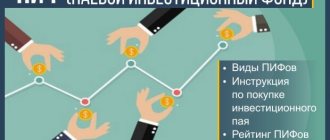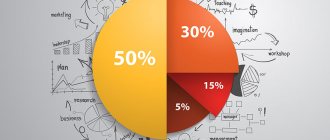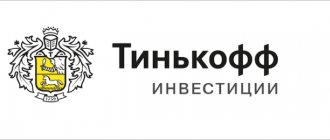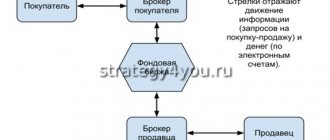Concept of investment risk
Investment risk is the probability of losing part or all of the invested capital or not receiving the planned profit.
Both investments and cash are at risk. Some can be lost due to the bankruptcy of the company in which the capital was invested. Others lose value due to inflation or may be stolen. Any money can turn into “paper” due to a default or economic crisis in the country that issues this currency.
Attitudes towards investment risks may vary. From extremely negative and panic, to absolute denial of its presence. But both the first and second options will not bring stability to the investor. Those who are terrified of risk keep their savings “under the pillow” and constantly lose money. Those who want to get rich as quickly as possible invest sums in dubious investment ideas, go to Forex or participate in financial pyramids.
Investment risk implies not only the choice of the investor, but also two other types of risk - systemic and non-systemic. They do not depend on the investor or his decisions.
| Systemic risks | Non-systemic risks |
| Market | Business |
| Interest rate risk | Financial |
| Foreign exchange | Operating |
| Inflationary | — |
| Random | — |
Some risks can be reduced through diversification, both across sectors of the economy and across countries whose assets will be purchased for the portfolio. Investment risks are described in more detail in a separate Brobank material.
How investment bonds differ from others
Main features of investment bonds:
- 100% return of the bond's face value on the maturity date;
- additional income depends on the price of the asset;
- the amount of income is expressed as a percentage of the growth of the asset.
A simple investment bond for the IMOEX index (RU000A1044X0) from Sberbank implies the following conditions for additional income:
- the IMOEX index must be greater than its value as of December 17, 2021;
- 0.1% of the index growth is paid every year;
- in five years, the entire increase in the index from December 17, 2021 to December 7, 2026 will be paid in addition to the bond’s par value of 1,000 rubles.
As a simplified example, we can assume that a certain index grows by 7% from the initial level every year, then the investor’s income will be calculated as follows:
Source: analytical department of GPB Investments
Investment bonds contain a simple investment strategy. Therefore, they are less risky than structured income bonds. You can learn more about the latter in the article “How to invest in structured securities.”
Some investment bonds have a basic coupon income with guaranteed payments, but the amount of this income is minimal - usually it is 0.01% of the face value.
More on the topic:
Learn to invest
December 02, 2021 Responsible investor: why invest in social bonds 15 minutes
Why investors take risks
Investors take risks to achieve higher returns. Any stock market participant can assemble a portfolio only from OFZs or other bonds issued by a reliable issuer. But the profitability will be low. It will only slightly exceed the profit on a bank deposit and, most likely, will not cover the real inflation rate. Therefore, you won’t be able to make money this way.
An investor can create a portfolio of “junk” stocks that have shown high returns in the past, or any other high-risk instruments. However, investing all your capital in such assets is too dangerous because you can lose all your money.
Determine the investment amount
Calculate exactly how much money you are willing to invest. The larger the investment amount, the more financial instruments are available to you.
Remember that investing is always a risk, so only invest money that you can actually afford to lose. This is a hackneyed truth, but it is often neglected in the pursuit of profit.
Regular investments are much more important than a large initial amount. Decide where you will get money for planned capital replenishment and portfolio rebalancing. This could be dividends, income from business, renting out an apartment, or simply 10% of each salary. Planned investments are needed to earn more - without them, the profitability of the portfolio will decrease significantly.
It is not necessary to wait until you have accumulated a large sum - say, $10,000. You can invest with $100. In the beginning, investors often make the simplest mistakes. It's better to let them in with a hundred-dollar portfolio than to lose significant savings.
Let's look at a specific example. Manager Arthur wants to build an investment portfolio and achieve his financial goal. To do this, he has accumulated 100,000 rubles and 20,000 rubles every month from renting out the apartment.
How assets differ in risk level
Financial instruments are characterized by a certain degree of risk:
- Deposits and money in bank accounts . The most risk-free option. Amounts up to 1.4 million rubles are protected by the deposit insurance system. Therefore, even if the bank goes bankrupt, the depositor will return the amount from the accounts within this limit.
- Bonds are debt receipts of the state, municipalities, large state and commercial companies. Investments in these assets are not insured by the state, but are also considered low-risk investments. The safest are OFZ. Most often, the yield on bonds is known in advance and the investor receives coupon payments throughout the holding period.
- ETFs are funds, mutual funds, indices and other structured instruments that include shares, bonds, currency or any other assets. They are risk balanced. This type of investment can be either risk-free, medium- or high-risk, depending on the share of assets in the structured instrument.
- Shares are a medium- or high-risk type of asset, depending on the issuer. Their cost is influenced by many factors. Such as the development strategy within the company, the situation in the country where the business is conducted, as well as global economic and political trends.
- Futures, options, warrants and other complex, high-risk investment products . It is impossible to predict the profitability of such assets without a deep dive into the topic. Therefore, investing the capital of novice investors and traders in them can lead to a complete loss of funds.
Each investor decides for himself whether to buy cryptocurrency in his portfolio, participate in Forex transactions and invest money in microfinance organizations. Such investments can bring much higher returns, but their risks are too high.
Whether to purchase gold and other precious metals for a portfolio or leave part of the money in foreign currency also depends on the investor. For these types of assets there is either no profit at all or it is minimal. Therefore, they are more often used as protective mechanisms against portfolio drawdowns. Some investors purposefully hold part of their capital in foreign currency in order to buy additional highly liquid assets when the market falls, when prices become lower.
Taking into account uncertainty and risk when assessing the investment activity of an enterprise
The concept of uncertainty and risks of investment activity
In the course of their activities, investors may lose part of the expected profit or invested funds as a result of adverse events. The nature of such events is very diverse: man-made disasters; local destructive wars; natural disasters; extreme economic crises; risky economic transactions, etc. As a result of such events, the economy of the country (region, industry, enterprise) may deteriorate, and material damage will be caused to a significant part of the population.
The occurrence of adverse events is often associated with the concepts of “danger” or “threat”, which in practice may not be realized, but if measures are not taken to protect against it, the damage caused by such an event can be very significant. "Danger of loss" is interpreted as "risk". In various branches of applied mathematics there is a dual interpretation of the concept of “risk”. In decision theory, risk is defined as the probability of the occurrence of an unfavorable event; in game theory, risk is interpreted as the quantitative value of the maximum damage caused as a result of the occurrence of an event; in management, it is most often considered as uncertainty in predicting the outcome.
The essence of risk can be revealed using its main components presented in Fig.
16.1. Rice.
16.1. Main components of risk
Uncertainty of an event - several options for the development of the same event are possible, the probability of the occurrence of each option cannot be assessed in advance, therefore the result of the outcome of the event can be either positive (happy outcome) or negative (significant losses).
In a real situation, decisions made in the investment process are almost always associated with risk, which is due to the presence of a number of uncertainty factors that were not foreseen in advance. They occur when the probabilities of consequences have to be determined subjectively, since there is no data from the previous period. There are three main groups of causes of uncertainty: the first group is ignorance, i.e. incompleteness, insufficiency of our knowledge about the world around us; the second group is the random occurrence of an event that occurs differently under similar conditions (equipment failure, change in demand for goods, unexpected disruption in product sales and cessation of supply, etc.); The third group of causes of uncertainty is the opposition of system elements. For example, the uncertainty of demand for products and the difficulties of their implementation, conflicts between the contractor and the customer, violation of contractual obligations, etc. These three groups of factors are components and serve as boundary conditions for the risk of the investment activity of the enterprise.
Losses
— in practice, in many cases, investment decisions are associated with risk, turn out to be inevitable, and it is not always possible to avoid risky actions. There is a potential danger of loss of resources or non-receipt of planned income, i.e. an unintentional reduction in the value of an enterprise’s property compared to an option that is designed for the rational use of resources in a given type of activity.
Possible losses of an enterprise as a result of investment activities can be divided into four classes: loss of property and resources as a result of a negative change in any process or the manifestation of powerful natural disasters; loss of expected position in a competitive environment; loss within the framework of current budgets (even fairly well thought out and developed business plans may not give the planned effect, since developments in the market economy and its infrastructure have not yet taken shape and are not sustainable, and therefore may turn out to be unpredictable).
To reduce the amount of losses, it is necessary to use methods to manage the main factors affecting the occurrence of risk and incur additional costs. Management is effective when relatively small costs produce large savings. With proper organization of the cost management system, losses should be reduced.
caring
— the risk affects not only the organization, but also certain individuals who sought to prevent an undesirable development of events for them. It is not always impossible to eliminate the uncertainty of the future, since it is an element of objective reality, and as market relations develop in our country, the degree of uncertainty and risk will increase.
Depending on the level of assessment, risks are divided into: national, industry, corporate, and associated with the position of an individual enterprise (investor).
Nationwide, or general economic
, the risk is associated with the political and economic situation in the country where the enterprise operates. This is an entrepreneurial risk created in a state or region. The main influencing factors are: threat to stability in the country, government stability, social stability; unemployment rate; attitude of local bureaucracy; the likelihood of armed conflicts with CIS countries; inflation, labor costs; level of taxation, etc.
Industry risk
- is associated with the stages of the industry’s life cycle, its position in relation to the business cycle and macroeconomic conditions, etc. The main influencing factors are: sales volume, income, dividends, growth of innovation at enterprises in this industry, etc.
There are the following stages of the life cycle of industries:
- pioneer stage, characterized by accelerated growth in sales and profits, high levels of risk and competition, the presence of new market participants and a relatively low level of capital investment;
- expansion stage, characterized by an increase in sales volumes without acceleration or with some slowdown, or a cessation of price growth or a slight decrease in them; a sharp influx of investment and significant costs for creating the potential of the enterprise, etc.;
- the stabilization stage, during which the growth of sales and profits stops or significantly slows down, the modernization of equipment and products stops, the assortment stabilizes, the growth of capital costs stops and their decrease is observed;
- the decay stage, characterized by a decrease in the number of companies operating in the industry, a decrease in sales, profits and capital investments.
The assessment of the cyclicality of the industry is based on comparing the dynamics of the main indicators of industry development with the dynamics of the same indicators in other industries. This allows industries to be classified as follows:
- growing industries whose growth is often obscured by the general economic downturn. Therefore, they are identified by comparing overall growth with industry growth;
- protected industries that do not depend on changes in the state of the economy as a whole (for example, these include food production);
- cyclical industries in which price and volume fluctuations occur in unison with general economic changes (for example, the production of electrical appliances);
- countercyclical industries - the development of these industries often peaks during relatively short and shallow economic downturns. A deep depression can lead to a drop in production in any industry;
- industries sensitive to changes in profitability - in such industries, fluctuations occur depending on changes in interest rates (for example, financial services).
Brand risk
— risk at the level of an individual enterprise. The manifestation of such risk depends on the level of general economic and industry risks. The influencing factors are also the quality of the management process and organization of financial and economic activities, its position in the industry.
By risk in the investment activity of an enterprise we mean the possibility of obtaining economic benefits (income) or the occurrence of additional, unforeseen losses (expenses) for the enterprise in conditions of dynamism and mobility of the operating environment.
The amount of economic benefits or unforeseen expenses received is influenced by external and internal environmental factors, the main groups of which are presented in Fig. 16.2.
Rice.
16.2. Risk factors for an enterprise's investment activity
The main factors of the internal environment of the organization influencing investment activity are:
- industrial: all kinds of breakdowns of machines, mechanisms, vehicles; failure of energy and water supply systems, roads and other communications; low quality of materials, parts, structures, equipment, which does not allow them to be used for their intended purpose; changes in investment decisions during the construction process, etc.;
- technological: elimination of defects, rework of poorly performed construction and installation works due to violations in technology; occurrence of unforeseen work, etc.;
- absence or low level of marketing policy being pursued - bias in sales market research, which leads to errors in the study of supply and demand in specific sales markets, to an imbalance in product production and sales volumes; unreasonable choice of sales channels for manufactured products, time and place of sale, etc.;
- low level of organization and control of the production process;
- socio-economic - changing the conditions for the movement of material, financial and labor resources between subjects of investment activity; changing the targets of subjects; the emergence of more advantageous offers; staff turnover due to insufficient wages, a decrease in the rhythm of construction, an increase in accidents due to low qualifications of personnel, etc.;
- organizational: violation of obligations to issue design and estimate documentation; for the supply of materials, structures, equipment; changes in personal relationships between the leaders of the subjects participating in the investment process; failure to meet deadlines for the work of any of the organizations participating in the investment project; lack of workers with the required specialty and qualifications, etc.;
- environmental - failure to comply with environmental requirements when releasing products, etc.
The main factors of the external environment and organizations influencing investment activity are:
- political instability (threat of strikes, property rights, etc.);
- unstable economic situation (ruble devaluation, rising prices for raw materials lead to an increase in the level of inflation, which in turn leads to a decrease in the purchasing power of the population, etc.); changes in tax legislation, the level of subject and technological specialization of construction products, the level of capital investments, etc.;
- demographic factors (it is necessary to take into account the specific requirements of certain demographic groups for the technical parameters of the product and its quality);
- environmental factors: snowfall, storm, rain, ice, accidents and explosions leading to large releases of highly concentrated substances; increased background radiation, sea, railway and aircraft accidents; location of high-risk facilities in one region and connected by a communications network into a single technological system, etc.
Factors influencing the investment activity of an enterprise can have both a negative (increasing the degree of risk) and a positive effect (counteracting factors) on the amount of risk. Depending on the nature of the outcome, the risk may be pure or speculative.
Pure risks mean the possibility of obtaining a negative or zero result. These include risks: natural - arise as a result of natural disasters, epidemics, environmental disasters; man-made - arise as a result of accidents at production, transport and other production facilities, environmental disasters; political - expressed in the inability to carry out economic activities due to military actions, aggravation of the internal political situation, nationalization of enterprises, confiscation of goods, imposition of an embargo; introducing a moratorium on external payments for a certain period; tax - associated with unfavorable changes in tax legislation, etc.
Speculative or commercial risks involve the possibility of obtaining both positive and negative results. These include: production risks associated with losses from production stoppages as a result of the impact of various factors on the enterprise’s property (equipment, raw material reserves, etc.), with the introduction of new equipment and technologies; property risks associated with the likelihood of property loss due to failures of technical and technological systems or theft, negligence, sabotage; trading risks associated with loss due to delay or refusal of payments during the transportation of goods; financial risks associated with the likelihood of loss of financial resources, for example, as a result of depreciation of money, falling product prices, changes in the exchange rate of foreign currency against another currency.
Risk factors according to the degree of controllability can be presented in the form of groups: controllable (regulated), conditionally unregulated (difficult to regulate) and uncontrollable (Fig. 16.3). The controllability of factors largely depends on the assigned management task, as well as the temporal and spatial conditions for its solution. The assignment of a factor to one group or another depends on the level of management being considered (construction company, workshop, enterprise, large joint-stock company, industry) and on the duration of the implementation period of the decision made. The higher the level of management, the more factors can be considered as controllable and the wider the boundary of their targeted change becomes. Many factors that are external constraint conditions at the firm level are considered manageable at the ministry or government level, for example the amount of taxes. The longer the period of implementation of the decision made, the wider the boundaries of difficult-to-control factors become.
Rice.
16.3. Classification of investment activity risks
The most relevant for the investment activities of an enterprise are risks.
Entrepreneurial risk
— the danger of a potential opportunity, the likelihood of losing resources or not receiving the planned income, i.e. income that can be obtained with rational use. Such a risk arises in any type of activity related to the production of products, goods and services, and their sale, as well as when carrying out financial transactions.
Financial risk
— the likelihood of losses arising when carrying out financial entrepreneurship or financial transactions when choosing a policy regarding the advisability of attracting certain sources of financing. The significance of financial risk is determined by the structure of long-term sources of financing. The higher the share of borrowed capital, the higher the level of financial risk. Borrowed capital, borrowed at a fixed interest rate, used for investment, must generate a profit that exceeds the fee for its use. If the profit from borrowed capital is lower than the loan fee, then the company incurs losses; the larger the amount of borrowed funds, the greater the losses. Considering that in financial entrepreneurship the role of goods is: currency, securities, cash, it includes: currency, investment and credit risks, tax risk.
Currency risk
— the likelihood of financial losses as a result of changes in exchange rates that may occur in the period between the conclusion of the contract and the actual settlement of payments on it. Currency risk includes: economic risk, translation risk and transaction risk.
The economic risk for an enterprise is that the value of its assets and liabilities may change up or down (in national currency) due to future changes in the exchange rate. This also applies to investors whose foreign investments - shares or debentures - generate income in foreign currency.
Translation risk is of an accounting nature and relates to differences in the accounting for a firm's foreign currency assets and liabilities. If the foreign currency in which the firm's assets are denominated depreciates, the value of those assets decreases. Translation risk is an accounting effect and has little or no reflection on the economic risk of the transaction.
Transaction risk
— the probability of cash foreign exchange losses on specific transactions in foreign currency. It manifests itself in changes in the exchange rate of future payment flows, and, consequently, in the future profitability of the entrepreneurial firm as a whole. This type of risk exists when concluding trade contracts, when receiving or providing loans and consists in the possibility of changes in the amount of funds received or payments when converted into national currency.
Factors influencing currency risk: inflation rate, inter-industry migration of short-term capital, the ratio of supply and demand for the transaction currency.
Investment risk is associated with the specifics of an enterprise's investment of funds in various investment projects. The level of investment risk is influenced by: incompleteness or inaccuracy of initial data on the conditions for implementing the investment project, in particular on the amount of costs and results; the occurrence of unforeseen situations and consequences during investment activities; a sharp change in market conditions, as well as various technical, commercial and political factors. The group of investment risks includes: interest rate, capital, selective, risk of lost profits, liquidity risk, inflation, operational, etc.
Selective risk is associated with the possibility of losses by an enterprise from the wrong choice of the method of investing capital, the type of securities for investment in comparison with other types of securities.
The risk of lost profits is associated with the loss of part of the income that could have been received. For example, an enterprise has invested its own funds in an investment project, the effectiveness of which may be less than the level of a bank loan. Or, for example, an enterprise does not enter into a property insurance contract; as a result of an insured event, it will not compensate for its losses, etc.
Interest rate risk
- this is the danger of a decrease in the organization’s net income and the market value of its capital due to changes in the level of market interest rates and the excess of the average cost of funds raised over the average cost of loans provided. Changes in interest rates affect the financial income of the organization and affect the amount of income. So, for example, if an enterprise issued a bond issue with a relatively high interest rate, and in subsequent periods interest rates on long-term financial instruments, due to the influence of certain factors, tend to decrease, then the enterprise will suffer losses. An increase in interest rates on short-term loans used by an enterprise to finance current activities leads to additional financial costs.
The main factors influencing the level of interest rate risk include: the stability of the country’s economy, the degree of stability of the financial institution, the close relationship between interest rate risk and credit risk, characteristics of the investment portfolio, etc.
The risk of a decrease in the purchasing power of the monetary unit - the appearance of this risk is influenced by rising prices for resources used in production, this leads to a decrease in the purchasing power of the monetary unit and an increase in inflation. Accordingly, the enterprise's profit and profitability decrease.
The risk of bankruptcy is a danger resulting from the wrong choice of method of investing capital, the complete loss of equity and the inability to pay off one’s obligations. As a result, the company becomes bankrupt.
Liquidity risk is associated with the possibility of losses for an enterprise when selling securities and goods as a result of changes in the assessment of their quality and use value. The liquidity risk of an investment object is due to the fact that investing in objects, such as fixed assets, has less liquidity than in other types, in particular securities and shares. The main reasons for the low liquidity of real investments: the real investment market is local, requires the attraction of significant financial resources, and with limited own funds, it is necessary to attract borrowed funds, the use of which leads to additional costs. The relationship between supply and demand for different types of real investments can vary significantly. If it is necessary to urgently sell an object, its cost may be significantly lower than the market value.
Investment management risk. The investment management process should aim to preserve invested capital and generate the required return on capital, however, it is possible that the level of investment management may decline, which could result in a decrease in the value of the property. In the decision-making process related to the choice of volumes and sources of financing, it should be taken into account that an attempt to obtain more income leads to increased costs, and therefore can lead to a decrease in the rate of return on investments.
The risk of the investment market is caused by significant changes in prices for production factors: raw materials, materials, energy, transport, etc. This negatively affects the change in the ratio of supply and demand for specific types of investments and the projected level of income from the investment object.
Capital market risk - there is a possibility that changes in the rate of return and interest rate on invested capital lead to a change in the value of the investment object.
Inflation risk is the probability of an unexpected change in real income (the degree of this risk for investments is insignificant, since with inflation, the cost of real estate and the level of rental rates tend to increase).
Tax risk
— the danger of unexpected financial losses and other losses arising for the subject of tax legal relations associated with the introduction of new types of taxes, an increase in tax rates for existing taxes, the cancellation of tax benefits or tax exemptions used by the enterprise, changes in the procedure and timing of tax payments from the norms or ambiguous interpretation of the tax legislation.
Tax risks that can be assessed in monetary terms are classified as financial risks. Tax risks associated with criminal liability are non-financial risks.
The main factors influencing the occurrence of tax risks for an enterprise are:
- the existing ambiguity of some tax regulations;
- insufficient level of qualifications of the enterprise's accounting employees in the field of taxation and financial management;
- underestimation of the relationships between the main indicators characterizing various aspects of the functioning of the enterprise, which in practice leads to the fact that an increase in the values of some indicators negatively affects others;
- large volume and complexity of business transactions reflected in the accounting registers, etc.
Legislative risk arises when legislation changes, which increases the likelihood of a decrease in the value of the investment object.
Environmental risk
— the likelihood of a decrease in income from the investment object as a result of exposure to unfavorable environmental factors.
Country risk.
The combined impact of external environmental factors characterizing the economic, social, political, fiscal and monetary policies of the state characterizes country risk, i.e. the risk of changes in current or future socio-political, economic and fiscal-monetary conditions in the country to the extent that they may affect the ability of the country and its enterprises to meet their obligations arising in the process of operation. This type of risk is typical for enterprises engaged in foreign economic activity; the level of risk depends on the political and economic stability of the countries with which import-export operations are carried out.
What is an investor's risk profile?
An investor's risk profile shows his personal attitude towards risk. This indicator depends on psychological characteristics, goals, age and time until the financial goal is achieved. In addition, the risk profile is influenced by qualifications, experience, volume of investments and method of portfolio management.
If at least one of these parameters is not taken into account, the investment will not live up to expectations. An investor may become disillusioned with the stock market. Then he will no longer waste time and effort studying information and building a portfolio.
Psychological characteristics and risk taking
The more money an investor is willing to lose, the more aggressive a strategy he can choose. But if any financial loss causes fear or even panic, it is better to stick to a conservative portfolio management style.
Cautious Investors:
- are not ready to bear big losses;
- will not take risks due to insufficient experience or psychological inability to do so;
- react sharply to stressful situations;
- are influenced by the information context and news hype.
Aggressive investors:
- gambling;
- like to take risks;
- do not panic when the market fluctuates;
- do not experience acute stress due to financial losses;
- have extensive experience and knowledge that allows them to take reasonable risks, or are guided by intuition.
If one person has two types of traits, most likely we are talking about a moderate or rational investor.
Financial goal, planning horizon and investor age
Some investors go to the stock market to become financially independent in 25-30 years. Others want to earn extra money to buy a car. Still others are building a portfolio for the future in order to educate their children or buy them a quart. Whatever the final goals, they need to be formulated in terms of amount and deadline. For example, like this:
- accumulate capital so that in retirement, after 25 years, you can receive passive income of 50,000 rubles per month;
- raise money in 10 years to purchase real estate for 2.5 million rubles;
- collect the amount for a child’s education at a higher educational institution in 12 years in the amount of 1.5 million rubles.
The faster the money invested in investments is needed, the more limited the choice of instruments is.
Experienced investors are guided by this rule: the shorter the planning horizon (shorter the investment period), the more conservative assets should be in the portfolio. In the last 2-3 years before the goal, the share of stocks and bonds may tend to a ratio of 20/80. They do this because the price of shares may fall sharply, and then it will not be possible to collect the planned amount.
All this also applies to the age of the investor; the older the investor, the more conservative strategy he has to choose. But some older market participants do things differently. The main part of the capital, 70-80%, is invested in assets with a minimal or average level of risk, and an aggressive portfolio is formed for the remainder. Such capital diversification with a high personal risk appetite helps achieve two goals at once:
- do not lose all your money at once;
- try to earn as much as possible by participating in aggressive strategies.
Investors who are 25 and 30 years old have more time to rebuild their capital, so they can maintain an aggressive risk profile. But as statistics show, even at this age, many investors prefer a moderate strategy.
Qualification
There are qualified and unqualified investors in the stock market. The state allows the former access to complex and risky, and therefore more profitable instruments, while the latter does not. Qualified investors will earn this right if:
- in their portfolio of securities in the amount of 6 million rubles;
- have experience working in Russian or foreign companies that conduct transactions with financial instruments for at least two or three years, depending on whether it is a qualified organization or not;
- frequency of transactions on the stock market at least once a month, on average 10 times a quarter and for an amount of at least 6 million rubles during the previous four quarters;
- have a higher economic education or a professional certificate, for example, financial market specialist or CFA.
Qualified investor status can be obtained through a broker or management company.
All other investors are classified as unqualified. But those who have experience in the financial sector, or the desire to thoroughly understand this issue, will be more successful. Beginning investors will benefit from courses on financial literacy, budget planning and feature articles about investments.
If you do not have experience and understanding of what cryptocurrency or Forex are, it is better not to rely on luck or recommendations from a hairdresser in a beauty salon in an attempt to earn a lot and quickly.
Experience and capital
It is advisable to enter the stock market if three conditions are met:
- Only with your own money . Using loans or credits for investing is not the best option. You can lose capital, but you still have to repay the debt to the creditor.
- After paying off all debts. If you already have debts on a mortgage, consumer loans or car loan, it is advisable to close them. Some even get rid of credit cards, others do not close them, but wisely use only those that have an interest-free period.
- With an accumulated financial cushion . The amount of the cash reserve should be equal to 6-12 times the average monthly expenses for all family members. If the cushion is not accumulated, investment capital will be at risk. In a situation where money is needed very urgently, the investor will not evaluate profitability and quotes, so he may lose too much when withdrawing funds.
For novice investors, more experienced colleagues recommend entering the market for the first time with a capital of several tens of thousands of rubles. It is advisable to invest money in structured instruments, bonds, shares of blue chip companies. When real experience of stock exchange transactions appears, the composition of the portfolio and the list of assets can be expanded.
From the very beginning, it is imperative to diversify risks and invest in different industries and countries. The minimum package of assets for a novice investor should include at least 5-10 securities.
The first transactions, the rise and fall of quotes, news around companies and market crashes will show how prepared the investor is for drawdowns, whether he can take risks and with what share of capital. Very often, those who enter the stock exchange for the first time have inflated expectations of themselves in terms of the degree of resistance to financial losses. Therefore, some beginners think that aggressive strategies are suitable for them. Real numbers put everything in its place.
The most valuable experience is investing in a falling market, when all assets become cheaper. It is very important to track how the investor feels and what actions he takes at this moment and retest the risk profile.
Portfolio management
You can form and manage an investment portfolio yourself or entrust it to a management company. Not all investors are ready to delve into the stock market, study assets and make difficult decisions on their own. Management companies remove these tasks and free up time, but you will have to pay for their services. They select assets, monitor quotes, make decisions on how to diversify a portfolio based on in-depth analysis and experience, but this does not completely eliminate risks.
Some investors combine portfolio management methods:
- some assets are purchased independently;
- Part of the money is used to buy shares of investment funds.
If the profitability of mutual funds is always higher, and there is less and less time and desire to dive in, you can transfer all the capital under the management of professional investors at any time.
Select control type
You can create a portfolio and forget about it. This is a passive management style in which the composition of the portfolio remains virtually unchanged.
To achieve maximum profitability, the portfolio must be actively managed: monitor the market situation, buy profitable assets and sell those that are falling in price. The main task of portfolio management is to maintain a balance between profitability and liquidity. With this management style, the composition of the portfolio changes frequently and dramatically depending on market conditions.
Arthur is a novice investor who does not have time to constantly monitor the market. Therefore, he wants to create a portfolio that does not need to be monitored all the time: Arthur is ready to change the portfolio structure maximum twice a year, and better - less often.
Why determine a risk profile?
The investor's risk profile is determined for two purposes:
- Determine your own attitude towards risk. The first test does not always give an objective result. It happens that after the first serious failure or, conversely, a successful experience, an investor changes his attitude to risk. Sometimes an aggressive investor becomes a cautious conservative, and a moderate investor becomes a hyper-aggressive trader. Drawing conclusions based on 2-3 transactions or on a growing market when the shares of all companies are rising in price is reckless.
- Create a balanced portfolio that is most suitable for the investor, taking into account his psychological characteristics, age, experience and other factors.
Focusing on your risk profile will help you achieve your financial goals and reduce the effects of levels of stress that may be beyond your control.
How is the participation rate calculated?
Participation ratio (PR) is a percentage of the growth of the underlying asset. The investor will receive additional income from the bond's face value equal to the growth of the asset multiplied by the participation coefficient.
Additional income = bond par value × participation rate, % × growth of the underlying asset, %
The higher the participation ratio, the higher the bond's potential return. For different issues of securities, the issuer may declare a different participation ratio, but for bonds already purchased, the participation ratio does not change.
Typology of investors by risk profile
There are several classifications of investors according to risk profile, but the most common division is into three types:
- Conservative (cautious) . The main task of such an investor is to preserve capital. He is psychologically ready for rates that slightly exceed the return on the deposit, but at the same time partially reduce the impact of inflation. A conservative investor invests most of his capital, up to 70-75%, in OFZs or bonds of reliable issuers. With the rest of the money he buys shares of blue chips, shares of reliable ETFs or shares of investment funds. When choosing stocks, he focuses on companies that consistently pay dividends.
- A moderate (rational) investor strives to obtain a higher return, for which he is willing to take on a certain level of risk. Allows fluctuations in the amount of capital in the short and medium term for the sake of planned profit. Divides the portfolio 50/50 - half of the funds are in OFZs and ETFs, the second part is in shares. The shares may include, but also some organizations from the second echelon.
- Active (aggressive) . The main goal of such an investor is maximum income. I am ready to invest in shares of high-tech companies, third-tier companies, emerging market securities and even cryptocurrency. Can participate in IPOs, trade on the derivatives market, or carry out transactions “with leverage,” that is, using borrowed money from the broker. An aggressive investor can spend from 70% to 100% of capital on such operations.
In the classification of risk profiles, transitional forms are very often found, such as moderate-aggressive, moderate-rational, professional or super-aggressive. As a rule, they represent an intermediate position between two neighboring types or a deeper form of one type.
What to remember
- When choosing investment methods, you should pay attention not only to their profitability, but also to the risks. For example, when investing in stocks, it is important to take into account that quotes are influenced by many factors: from the state of the global economy to the financial results of the company.
- Risk analysis will allow you to better understand what potential losses you are willing to accept for the sake of high profitability, and will help you choose the optimal investment instruments.
- It is almost impossible to reduce risks to zero, but you can significantly reduce them through proper diversification of investments, strict adherence to the chosen strategy and careful study of investment instruments.
- #Stock
- #Tips for beginners
Was the article helpful?
Thanks for the answer!
How to find out your risk profile
You can find out the investor’s risk profile on the Moscow Exchange website or in other open sources. It is better to find out this information before purchasing assets. Based on the test results, it is easier to understand which securities are best to form your first portfolio from. If there is no time for the test or its results seem ambiguous, choose the scenario that suits best.
The easiest way to determine your risk profile is by answering the question: what actions will you take if the value of assets in the portfolio decreases by more than 25% and capital within 3 months turns from 500,000 rubles into 125,000:
- I will sell all assets and put the money received into a deposit.
- I will sell securities that have fallen in price and buy less risky assets for this amount.
- I will not do anything, but will wait for the capital to be restored.
- I will take advantage of the market situation and buy additional assets that have fallen in price with additional funds, increasing the size of the investment.
The first answer characterizes a conservative investor. The second and third options for moderately rational, rational or moderately aggressive investors. The fourth answer will be chosen by aggressive or professional traders hoping to make money from a falling market.
Why invest in crowdlending?
If an investor wants to receive a regular, stable income of 20-30% per annum, he should take a closer look at a new investment mechanism - crowdlending. Investments in crowdlending are convenient because you can quickly return money and receive interest with the same level of risk (or even lower) than when investing in traditional instruments.
Crowdlending works simply - ordinary people, using a special Internet service, lend money to other people or companies at interest. The platform connects lenders and borrowers, guarantees the security of the transaction and takes a small percentage for it.
The lender and borrowers agree on the terms themselves. Typically, for a borrower, the overpayment interest is less than at a bank, and for lenders, the interest on the loan is higher than the interest on the deposit.
Penenza is a crowdlending platform for businesses. It issues only targeted loans: to secure an application, to fulfill a contract, a loan of materials and government factoring.
The average loan term in Penenza is 25 days. The share of delays is 0.4%. The minimum income is 1.66% per month of the loan amount. The average return for investors is 20% per annum in rubles.
20% per annum is the average yield of Penenza
Investments in crowdlending can bring about 20% per annum in a short time. At the same time, you don’t need to monitor the stock exchange, think about which securities to sell and which to buy.
By lending money to a business, a Penenza investor risks less than lending money to a friend or neighbor. If he doesn't return the money, it will be difficult to get it back. But Penenza checks state registers, founders, financial statements and assigns a rating to each borrower and loan. If the borrower delays payments, the service itself handles debt collection.
The investor himself decides to whom to give how much money and under what conditions. For greater security, you can divide your portfolio between several borrowers - diversify your portfolio. Distributing one debt among many investors is safer than investing in the borrower yourself. If something happens, the lender will only lose part of the money.
Summary
- The composition of the portfolio and the level of its profitability depend on the investor’s risk profile.
- The lowest level of risk is for bank deposits and bonds.
- The riskiest ways to make money are investing in cryptocurrency or Forex trading.
- You can choose one of the three classic types for your risk profile, or go deeper into the issue and determine an intermediate option.
- An investor's risk profile is influenced by an investor's character, purpose, age, investment horizon, qualifications, experience, volume of investments and method of portfolio management.
Give your rating
about the author
Klavdiya Treskova - higher education with qualification “Economist”, with specializations “Economics and Management” and “Computer Technologies” at PSU. She worked in a bank in positions from operator to acting. Head of the Department for servicing private and corporate clients. Every year she successfully passed certifications, education and training in banking services. Total work experience in the bank is more than 15 years. [email protected]
Is this article useful? Not really
Help us find out how much this article helped you. If something is missing or the information is not accurate, please report it below in the comments or write to us by email
What is full capital protection?
Capital protection is the percentage of the bond's face value that the issuer pays on the maturity date. He undertakes to return it under any conditions other than default and bankruptcy. Full capital protection - return of 100% of the bond's face value.
Investment bonds are most often issued with full capital protection, so if the value of the underlying asset falls, the investor only loses the broker's commission for purchasing the bond. When investing in an asset directly, if it falls by 40%, the investor will lose the entire 40% of the investment.
More on the topic:
Learn to invest
December 08, 2021 Taxation of bonds: what to pay for and how you can save 8 minutes
Comments: 0
Your comment (question) If you have questions about this article, you can tell us. Our team consists of only experienced experts and specialists with specialized education. We will try to help you in this topic:
Author of the article: Klavdiya Treskova
Consultant, author Popovich Anna
Financial author Olga Pikhotskaya
Risks and returns
The more investment risks a particular instrument carries, the more profitable it is, as a rule. But this rule does not always apply, since the same tools, when used differently and in different countries, give completely different effects.
Traditionally, any risks of investing in Russia are higher than in developed countries . And investing in the economies of developing countries in Asia, Africa or South America is more risky than investing in our country. But also more profitable. This effect is called the “risk premium” – i.e. the greater the potential risk, the more you can earn.
Typically, the risk/return ratio is compared with the amount of inflation and the value of the Central Bank key rate:
- If an instrument gives a return lower or equal to these two indicators, then it can be classified as low-risk.
- If the potential return exceeds the indicators by 2-3 times, then the asset will be very risky for an inexperienced investor.
Thus, in Russia, the least risky assets are considered to be bank deposits and federal loan bonds, which provide income at a level less than or slightly above the key rate. Riskier assets include blue chip stocks and bonds, as well as municipal bonds. They can provide income of 10-15% per year.
Even more risky assets in the stock market are shares and bonds of second-tier companies, structured products (for example, IIS), and currency. The profitability of these instruments can reach 20-25% per annum, but with the same probability you can receive a loss of a similar size.
Potentially dangerous for investors, and bearing the highest investment risks , are investments in startups, PAMM accounts, forex, cryptocurrency, junk bonds, penny stocks and other dubious assets.
Summarize
There are many tools and approaches to risk management. This article only covers the basics. The main thing to remember is that risks are dynamic. They need to be monitored and the portfolio periodically adjusted to match loss levels that are acceptable to the investor. If you don’t get carried away with one-time benefits, but work with risks systematically, then the result will not be long in coming.
#Investment portfolio #Finance #Investments
18/05/2021
Author of the article
Denis Salyakhutdinov
Co-founder of DS Consulting
Did you like the article? Save it for yourself or send it to a friend:











